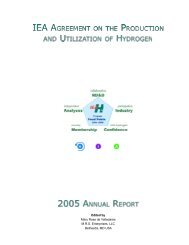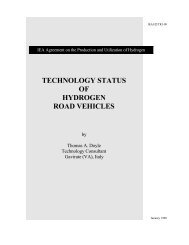stand-alone renewable energy system based on hydrogen production
stand-alone renewable energy system based on hydrogen production
stand-alone renewable energy system based on hydrogen production
You also want an ePaper? Increase the reach of your titles
YUMPU automatically turns print PDFs into web optimized ePapers that Google loves.
RE <str<strong>on</strong>g>system</str<strong>on</strong>g> comp<strong>on</strong>ents have substantially different voltage-current characteristics and are<br />
integrated through the developed power c<strong>on</strong>diti<strong>on</strong>ing devices <strong>on</strong> a 48V DC bus, which allows<br />
power to be managed between input power, <str<strong>on</strong>g>energy</str<strong>on</strong>g> storage and load. The DC-DC c<strong>on</strong>verters<br />
are used as power c<strong>on</strong>diti<strong>on</strong>ing devices to c<strong>on</strong>nect the fuel cell and the electrolyser <strong>on</strong> the DC<br />
bus, which have different voltage ratings. Also the DC-DC c<strong>on</strong>verters give high flexibility to<br />
c<strong>on</strong>trol power flow and operati<strong>on</strong> of the electrolyser and the fuel cell. Compared to the DC bus<br />
voltage, the fuel cell output voltage is low and hence the DC-DC boost c<strong>on</strong>verter is used to<br />
transfer the power effectively to the DC bus. Similarly, the DC-DC buck c<strong>on</strong>verter has been<br />
used between the electrolyser and the DC bus to transfer the excess power effectively to the<br />
electrolyser. In additi<strong>on</strong>, the <str<strong>on</strong>g>system</str<strong>on</strong>g> is equipped with AC and DC programmable loads and with<br />
a 10 kW programmable power source. The schematic of the RE <str<strong>on</strong>g>system</str<strong>on</strong>g> is shown in Figure 1<br />
and the <str<strong>on</strong>g>system</str<strong>on</strong>g> comp<strong>on</strong>ents’ specificati<strong>on</strong>s are given in Table 1.<br />
Table 1: Specificati<strong>on</strong>s of the <str<strong>on</strong>g>renewable</str<strong>on</strong>g> <str<strong>on</strong>g>energy</str<strong>on</strong>g> <str<strong>on</strong>g>system</str<strong>on</strong>g> comp<strong>on</strong>ents<br />
Comp<strong>on</strong>ent<br />
Wind Turbine Generator<br />
Photovoltaic Array<br />
Electrolyser<br />
Buck C<strong>on</strong>verter<br />
Fuel Cell System<br />
Boost C<strong>on</strong>verter<br />
C<strong>on</strong>troller<br />
DC Load<br />
AC Load<br />
Inverter<br />
Battery<br />
Power Source<br />
H2 Storage<br />
Specificati<strong>on</strong>s<br />
10 kW, 3φ permanent magnet alternator, VCS-10 - 48 V DC,<br />
Bergey– BWC Excel<br />
1 kW (peak) PV array, Golden Genesis GP 64 PV Modules (4S*4P)<br />
with Charge C<strong>on</strong>troller<br />
5 kW, alkaline electrolyser with compressor, Stuart Energy System<br />
5 kW, multiphase PWM, 36-48 Volt, HRI System<br />
5 kW, prot<strong>on</strong> exchange membrane fuel cell stack (MK5-E), 19-35 Volt,<br />
Ballard Power System<br />
5 kW, multiphase PWM, 24-48 Volt, HRI System<br />
<str<strong>on</strong>g>energy</str<strong>on</strong>g> management c<strong>on</strong>trol <str<strong>on</strong>g>system</str<strong>on</strong>g>, HRI System<br />
12 kW (programmable), water cooled, Dynaload<br />
3 kW (programmable), California Instruments<br />
5 kW, Trace Engineering<br />
42.240 kWh<br />
10 kW (programmable), Elgar<br />
10 bar, 3.8 m 3 represents 125 kWh of stored <str<strong>on</strong>g>energy</str<strong>on</strong>g><br />
Current from the DC bus bar keeps batteries (short-term <str<strong>on</strong>g>energy</str<strong>on</strong>g> storage) charged, feeds power<br />
to the load bank via an inverter and also supplies power to electrolyser via the powerc<strong>on</strong>diti<strong>on</strong>ing<br />
device. To simulate any type of electrical load profile, we used DC and AC<br />
programmable loads. Our RE <str<strong>on</strong>g>system</str<strong>on</strong>g> also has a programmable power source at DC bus and<br />
can be used to test the <str<strong>on</strong>g>system</str<strong>on</strong>g>, when there is no power available from wind and solar <str<strong>on</strong>g>energy</str<strong>on</strong>g><br />
<str<strong>on</strong>g>system</str<strong>on</strong>g>. The programmable power source can simulate any type of intermittent power output.<br />
- 3 -













